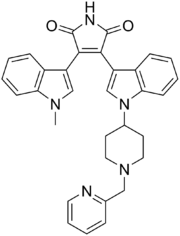Enzastaurin
 | |
| Names | |
|---|---|
| IUPAC name
3-(1-Methylindol-3-yl)-4-[1-[1-(pyridin-2-ylmethyl)piperidin-4-yl]indol-3-yl]pyrrole-2,5-dione | |
| Other names
LY-317615 | |
| Identifiers | |
| 170364-57-5 | |
| 3D model (Jmol) | Interactive image |
| ChEMBL | ChEMBL300138 |
| ChemSpider | 153463 |
| ECHA InfoCard | 100.233.143 |
| 5693 | |
| PubChem | 176167 |
| UNII | UC96G28EQF |
| |
| |
| Properties | |
| C32H29N5O2 | |
| Molar mass | 515.62 g·mol−1 |
| Except where otherwise noted, data are given for materials in their standard state (at 25 °C [77 °F], 100 kPa). | |
| | |
| Infobox references | |
Enzastaurin is a synthetic bisindolylmaleimide with potential antineoplastic activity. Binding to the ATP-binding site, enzastaurin selectively inhibits protein kinase C beta, an enzyme involved in the induction of vascular endothelial growth factor (VEGF)-stimulated neo-angiogenesis. This agent may decrease tumor blood supply, preventing growth.
In 2013 it failed a phase III clinical trial for lymphoma.[1]
References
External links
- Enzastaurin hydrochloride, National Institutes of Health
This article is issued from Wikipedia - version of the 6/25/2015. The text is available under the Creative Commons Attribution/Share Alike but additional terms may apply for the media files.